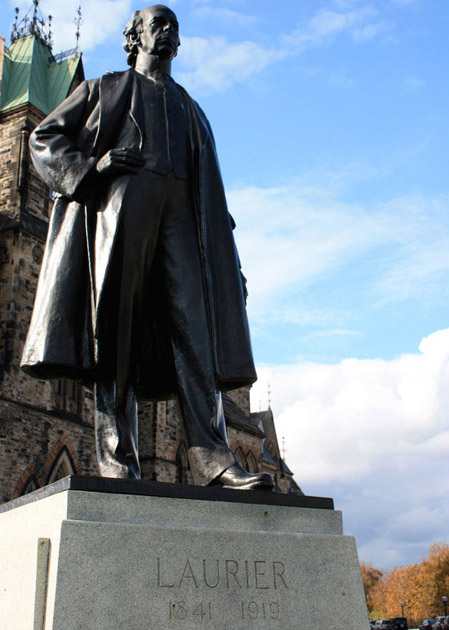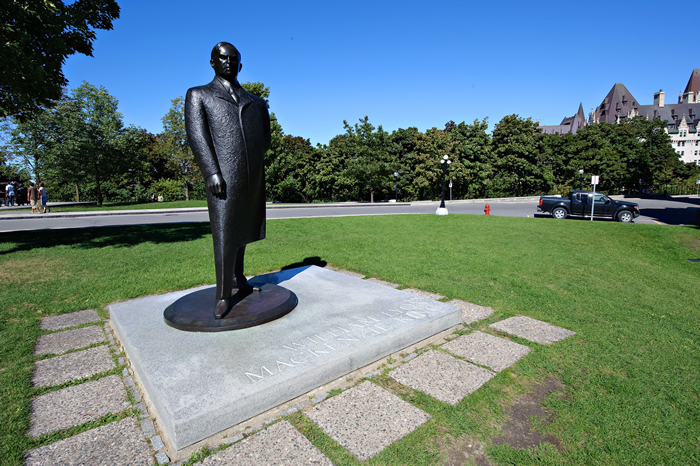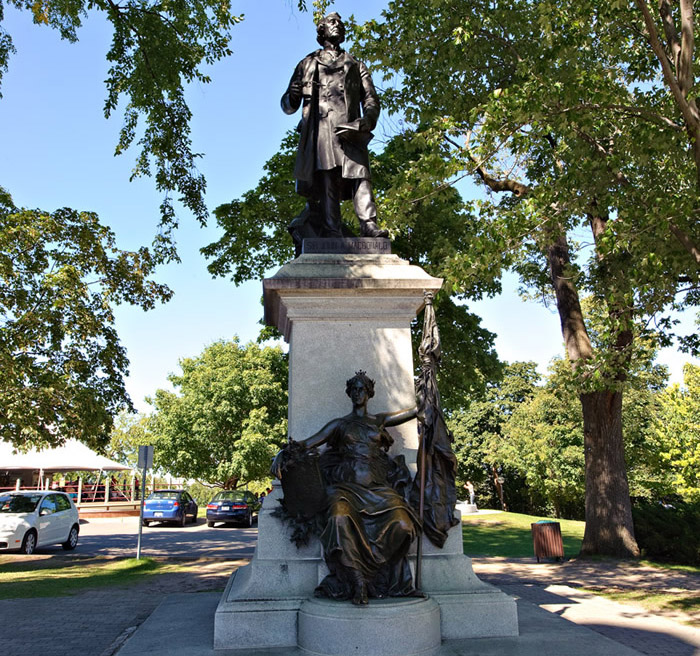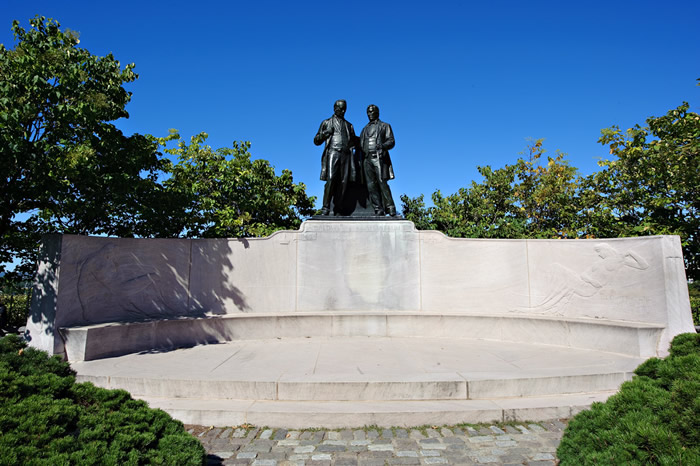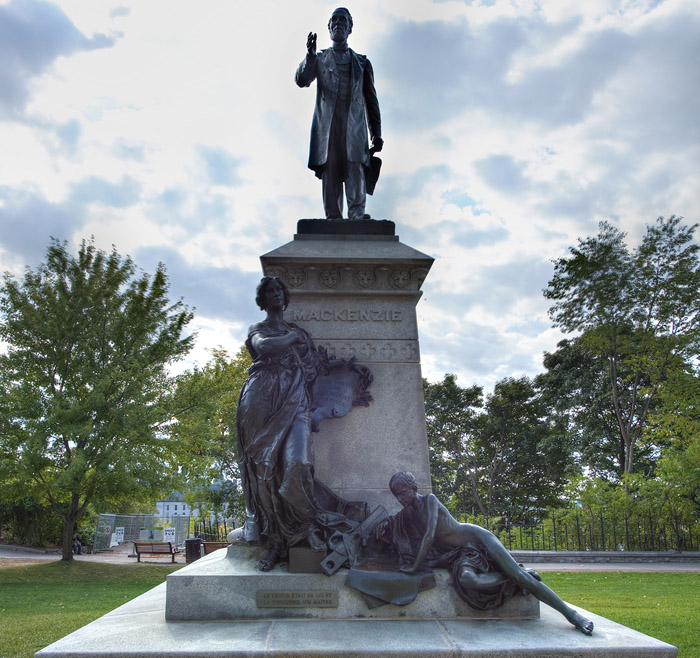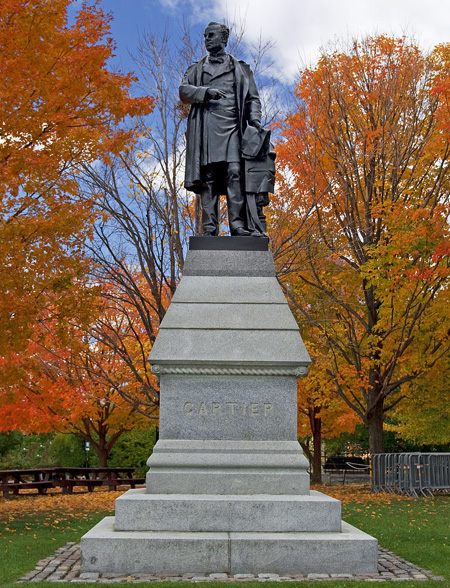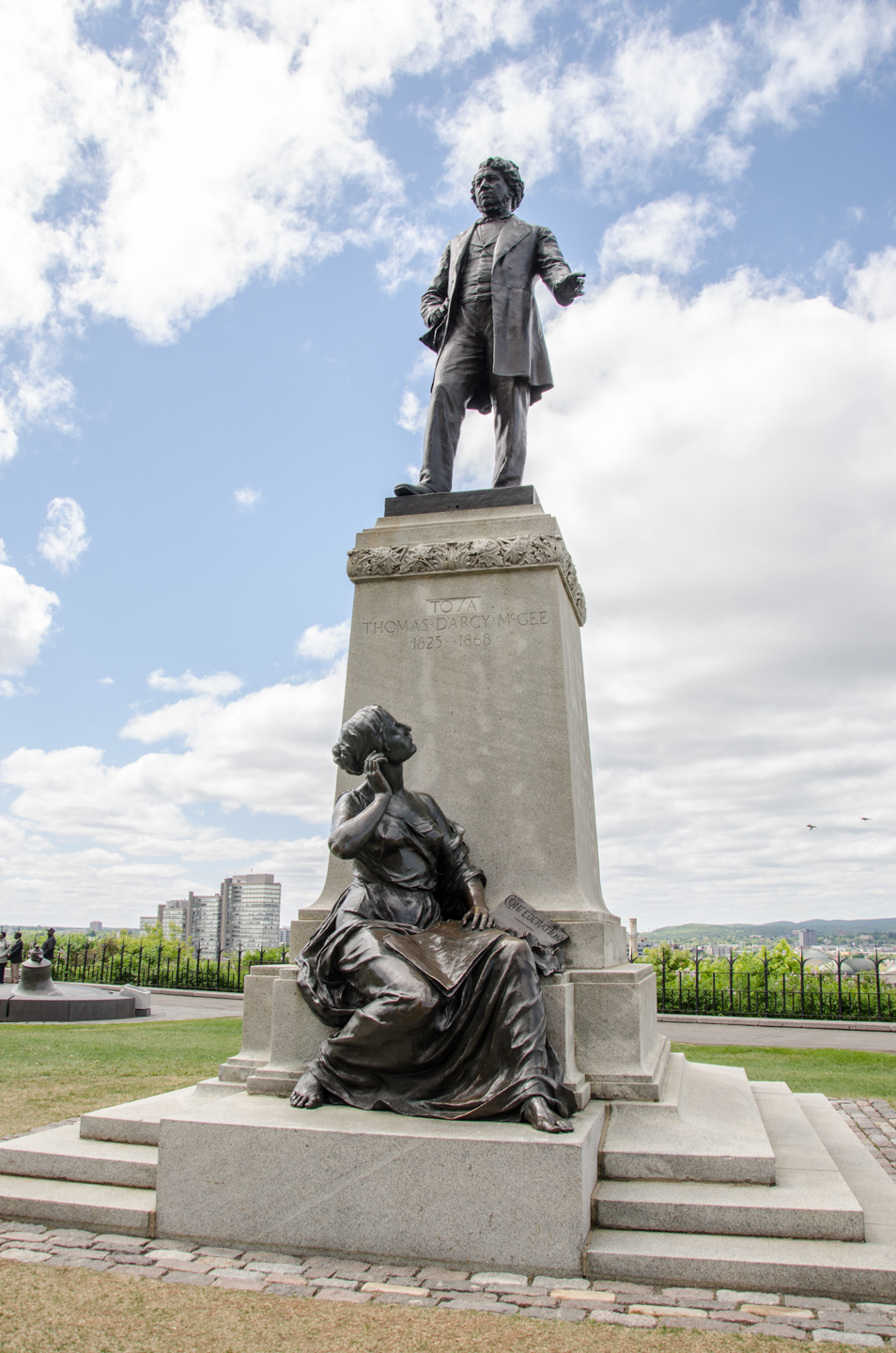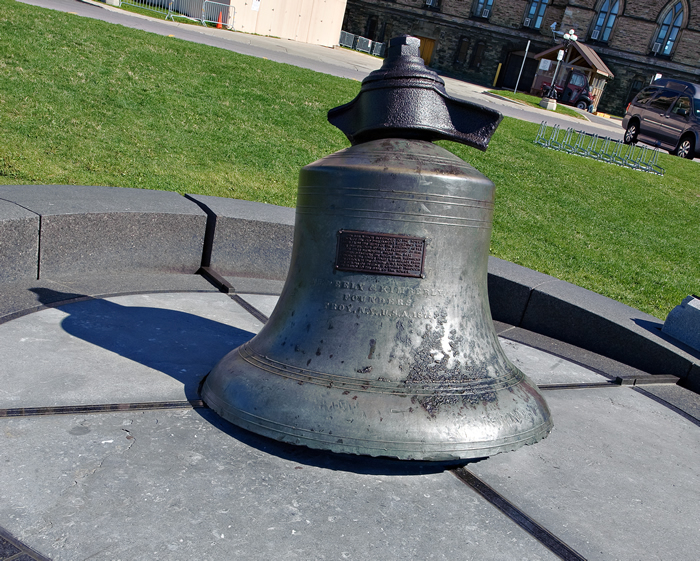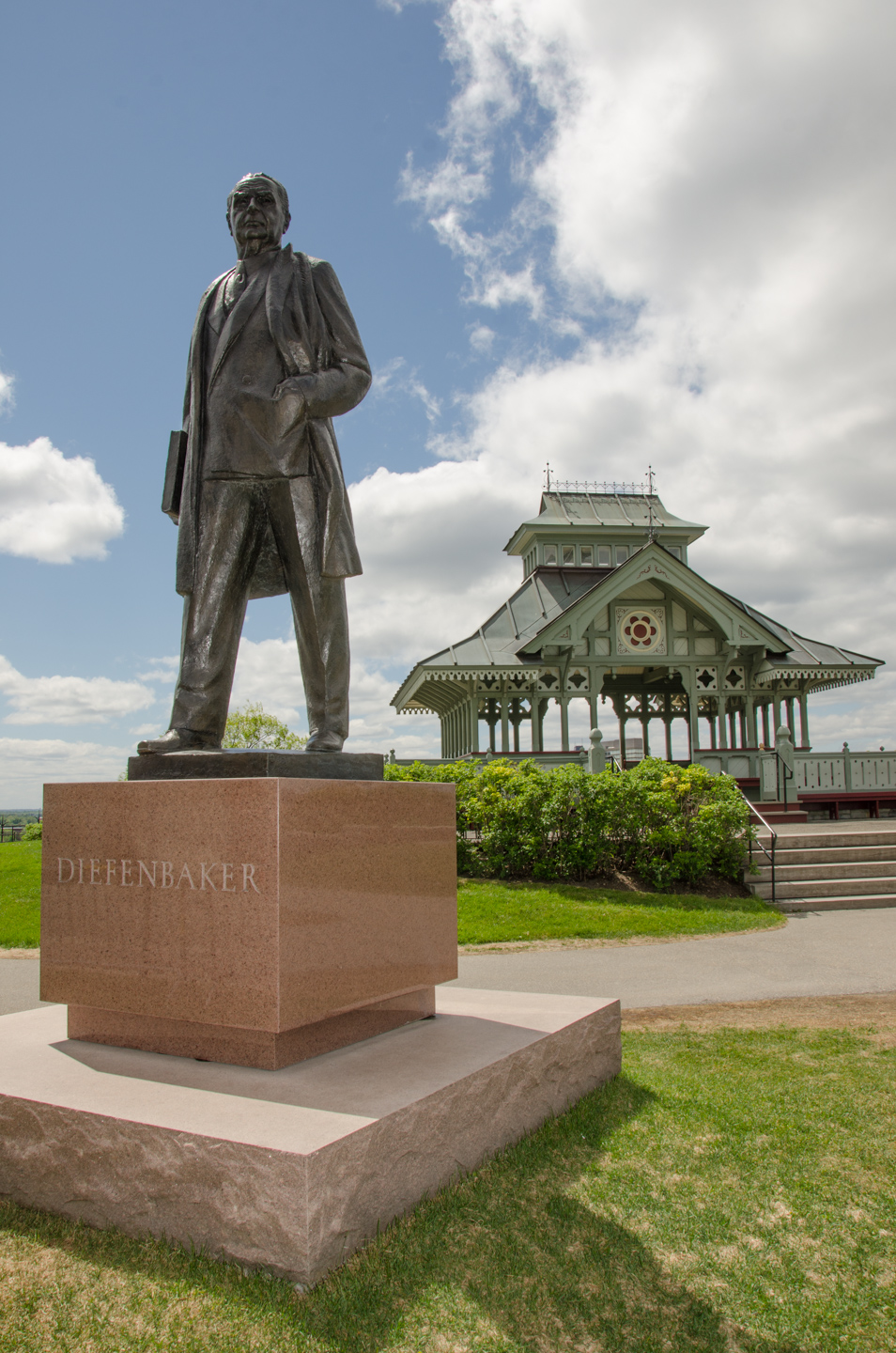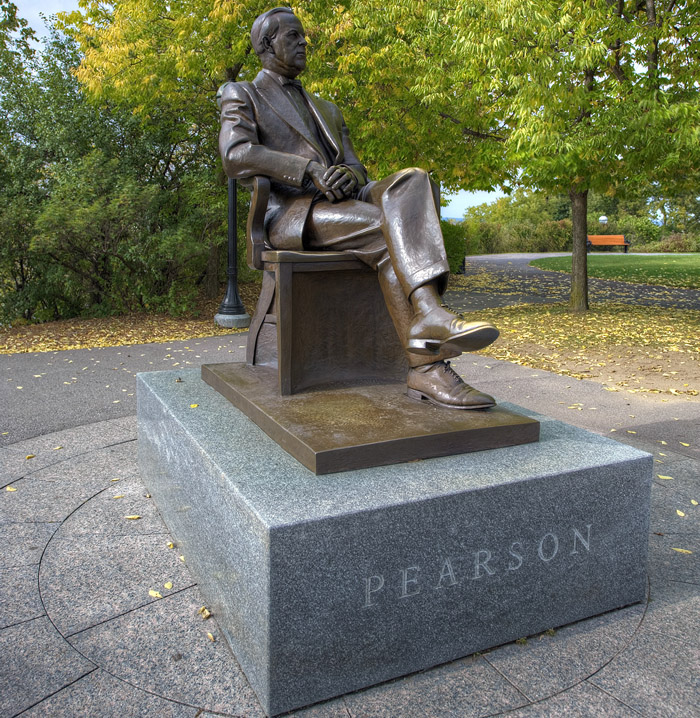Explore the statues, monuments and memorials of the Hill
The grounds of Parliament Hill are home to more than 20 bronze statues and monuments. The grounds are also home to the Canadian Police and Peace Officers' Memorial. The first statue was of Sir George-Étienne Cartier in 1885. This statue marked the first act of commemorating important people in Canadian history on Parliament Hill.
Sir Wilfrid Laurier (1841–1919)
Biography
Sir Wilfrid Laurier served as Canada's first francophone prime minister from 1896 to 1911. During his leadership, Canada experienced growth and prosperity. Under his administration, Alberta and Saskatchewan joined Confederation. As well, the last British troops were withdrawn from Canada and the Royal Canadian Navy was founded.
The statue
In 1922, plans began for a statue of Laurier. The competition for designing the monument received 40 entries from artists around the world. The winning entry was from Joseph-Émile Brunet, a young artist from Montréal. He would later become one of Quebec's foremost figure sculptors.
War of 1812 monument
The monument
The War of 1812 monument was created by Toronto sculptor Adrienne Alison. Entitled Triumph Through Diversity, the monument commemorates the 200th anniversary of the conflict. Its central granite base symbolizes the rocky cliff of Parliament Hill. Its granite boat-shaped bases represent maritime battles and the arches of the Parliament Buildings.
The seven bronze figures represent the key combatants that came together to defeat the American invasion. The monument reveals:
- a Métis fighter firing a cannon
- a woman bandaging the arm of a Voltigeur—a French combatant
- a Royal Navy sailor pulling a rope
- a First Nations warrior pointing into the distance
- a Canadian militiaman raising his arm in triumph
- a member of the British Army's Royal Newfoundland Regiment firing a musket.
The Famous Five
"Women are Persons!"
In 1929, five women won the Persons Case. The case led to a court ruling that declared women as persons under the law and made them eligible for appointment to the Senate in Canada.
Edmonton artist Barbara Paterson created larger-than-life sculptures to commemorate the five women in a monument entitled "Women are Persons!"
Inaugurated in 2000, the sculptures show the five women celebrating their important legal victory. An empty chair allows visitors to actively participate in the monument. McClung's newspaper uses some of the actual headlines printed across Canada at the time of victory.
The five women are:
Henrietta Muir Edwards (1849–1931)
Journalist, suffragist and organizer, Edwards started the Working Girls' Association in 1875. This organization was a forerunner of the Young Women's Christian Association (YWCA). Later in life, she moved to Alberta and wrote two books about the effect of federal laws on women and children.
Louise McKinney (1868–1931)
A politician and temperance campaigner, McKinney was president of the Dominion Women's Christian Union. She was elected to the Alberta legislature in 1917, representing the Non-Partisan League.
Nellie McClung (1873–1951)
Novelist, journalist, suffragist and temperance worker, McClung was a member of the Alberta legislature. She was the only woman on the Dominion War Council and the first woman on the Canadian Broadcasting Corporation (CBC) board of governors.
Irene Parlby (1868–1965)
A suffragist and politician, Parlby was elected president of the women's branch of the United Farmers of Alberta in 1916. She became a member of the Alberta legislature in 1921. Parlby was still a member of Alberta legislature at the time of the Persons Case.
Emily Murphy (1868–1933)
The instigator of the Persons Case, a writer and the first woman magistrate in the British Empire, Murphy pioneered married women's rights. She was National President of the Canadian Women's Press Club from 1913 to 1920, vice-president of the National Council of Women and first president of the Federated Women's Institutes of Canada.
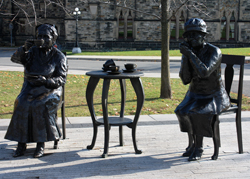
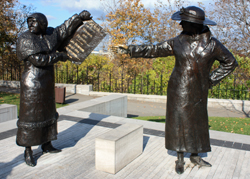
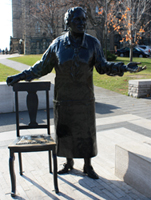
William Lyon Mackenzie King (1874–1950)
Biography
As the father of unemployment insurance, family allowance, and Canadian citizenship, King's accomplishments continue to affect the day-to-day lives of every Canadian. Leading the country in the 1920s, 1930s and 1940s, King held power for almost 22 years.
The statue
Built in 1967, this was the first of four statues to commemorate the prime ministers who played major roles in the shaping Canada. Quebec artist Raoul Hunter strove to convey the forcefulness and determination that defined the strength of King's character.
Queen Elizabeth II (1926–)
Biography
Queen Elizabeth II has reigned as Canada's monarch since 1952.
The statue
The monument was unveiled as part of Canada's 125th anniversary celebrations in 1992. Her Majesty is featured on her horse, Centenial (with one "n"), the former RCMP horse that was officially presented to Her Majesty in 1977.
British Columbia sculptor Jack Harman and his staff of ten worked for two years to create this monument.
Sir John A. Macdonald (1815–1891)
Biography
As Canada's first Prime Minister and one of the Fathers of Confederation, Macdonald's role in shaping this country is unparalleled. During his years as prime minister, the young nation experienced rapid growth and prosperity. As well, Manitoba, British Columbia and Prince Edward Island joined Confederation. And the last spike of the Canadian Pacific Railway's transcontinental line—linking British Columbia with Eastern Canada—was driven into the ground.
The statue
The competition to build Macdonald's statue received nearly 50 proposals from across Canada, the United States and Europe. The winning design was awarded to Quebec artist Louis-Philippe Hébert.
George Brown (1818–1880)
Biography
As a newspaper editor, politician and one of the Fathers of Confederation, George Brown first became active in politics in 1844. Having founded a newspaper in Toronto called the Globe (which became the Globe and Mail), he and his newspaper lent support first to responsible government and later to the Confederation movement. He also fought for Confederation while serving as a member of Parliament from the 1850s to 1867.
The statue
Installed in 1913, this statue was created by Quebec artist George William Hill. In creating this statue, Hill emphasized the importance of Brown's support for the cause of responsible government.
Robert Baldwin (1804–1858) and Sir Louis-Hippolyte Lafontaine (1807–1864)
Biography
Baldwin and Lafontaine are considered the Fathers of Responsible Government in pre-Confederation Canada, and they paved the way for its peaceful democratic independence.
The statue
The monument was erected in 1914 in tribute to these two statesmen. Ontario sculptor Walter Seymour Allward was chosen unanimously by the then newly formed Advisory Arts Council, a body formed to advise the government on matters of art.
Alexander Mackenzie (1822–1892)
Biography
During his five years as prime minister, Mackenzie oversaw the establishment of the Supreme Court of Canada and the Office of the Auditor General of Canada. He also introduced changes to election laws that included the right to secret ballot and universal male suffrage. Sir Wilfrid Laurier described Mackenzie as one of the truest and strongest characters in Canadian history.
The statue
Quebec sculptor Louis-Philippe Hébert won the competition to design the monument. First displayed at the Universal Exposition in Paris in 1900, the statue of Mackenzie was placed on Parliament Hill in 1901.
Sir George-Étienne Cartier (1814–1873)
Biography
Banished early in his political career for participating in the Rebellion in Lower Canada in 1837, Sir George-Étienne Cartier would go on to be made a baronet for his integral role in Canadian Confederation. Cartier formed a joint ministry for a United Canada from 1857 to 1862 with long-time friend Sir John A. Macdonald. Cartier died in 1873 at the age of 58.
The statue
Deeply affected by Cartier's death, Macdonald proposed that he be given both a state funeral and a commemorative monument. As the first monument to be erected on Parliament Hill, the competition attracted entries from Canada, the United States, Great Britain and Italy. The winner, Quebec sculptor Louis-Philippe Hébert, would go on to create three more monuments for Parliament Hill.
Thomas D'Arcy McGee (1825–1868)
Biography
A Father of Confederation and a great orator, Irish-born Thomas D'Arcy McGee was one of the most vigorous supporters of Canadian Confederation. McGee was also known for speaking out against the Fenians, a group of Irish-Americans who sought to invade Canada in the 1860s. His opposition to this group may have caused his death. He was shot and killed in 1868, by an assassin whom many believe was a Fenian.
The statue
The competition for this statue was held simultaneously with one for a statue of George Brown. Both men were strong advocates of Confederation and both met violent and untimely deaths. Quebec sculptor George William Hill won both competitions.
Victoria Tower Bell
The first tower bell
The Victoria Tower Bell, cast in 1875 and installed in the Victoria Tower in 1877, came crashing down from the Tower in the Centre Block fire of 1916. It serves as one of the few remaining links to Canada's first house of Parliament.
The monument
This monument is showcased on a circular granite base, which is etched as the face of a clock to represent the bell's role in keeping time. The bell sits on an incline, recalling its position in the ground after falling from the Tower.
In 2000, the monument was restored with the financial support of the Canadian Bankers Association.
Sir Robert Laird Borden (1854–1937)
Biography
As prime minister during the First World War, Sir Robert Borden made a significant contribution to Canada's nationhood. He argued successfully that Canada and other countries in the British Empire should be recognized as autonomous nations, both in command of their own troops and in treaty negotiations at the end of the war. In 1918, his government passed the Women's Franchise Act, giving all women the right to vote in federal elections.
The statue
Of the 29 entries submitted to the contest for this statue, the winner was Toronto-based sculptor Frances Loring. The monument was unveiled at the opening of a new session of Parliament in 1957.
John George Diefenbaker (1895–1979)
Biography
As Canada's 13th prime minister, from 1957 to 1963, John Diefenbaker introduced the Canadian Bill of Rights and extended the vote to include Native peoples. He was also the first prime minister to appoint a woman to the federal cabinet. He served as a member of the House of Commons until his death in 1979.
The statue
In 1985, a motion for a monument in honour of Diefenbaker was passed unopposed in the House of Commons. Winnipeg-based artist Leo Mol, who had known Diefenbaker personally, was awarded the project.
Canadian Police and Peace Officers' Memorial
On March 22, 1994, Prime Minister Jean Chrétien joined the more than 700 police officers and relatives of slain officers to inaugurate the new memorial site at the pavilion behind the Parliament Buildings.
The Canadian Police Association and the Canadian Association of Chiefs of Police dedicated the new Canadian Police Memorial Pavilion and its granite stone, which contains the names of the 227 officers killed on duty since 1879. Two other stones were erected: one for peace officers who died on duty and another explaining the pavilion's history.
Today, the memorial site contains the names of slain officers from a number of law enforcement agencies from across the country.
On September 24, 1998, the Government of Canada officially proclaimed the last Sunday of September of every year as Police and Peace Officers' National Memorial Day.
In spring 2016, to allow major rehabilitation projects to proceed, the memorial was relocated across Parliament Hill from its position near the pavilion to near the Famous Five monument. The memorial will be returned to its original location upon completion of the projects.
Learn more about the history of the Canadian Police and Peace Officers' Memorial Association.
On September 24, 1998, the Government of Canada officially proclaimed the last Sunday of September of every year as Police and Peace Officers' National Memorial Day.
In spring 2016, to allow major rehabilitation projects to proceed, the memorial was relocated across Parliament Hill from its position near the pavilion to near the Famous Five monument. The memorial will be returned to its original location upon completion of the projects in early 2017.
Learn more about the history of the Canadian Police and Peace Officers' Memorial Association.
Queen Victoria (1819–1901)
Biography
Canada's monarch from 1837 to 1901, Queen Victoria officially chose Ottawa as the permanent capital of the then-United Province of Canada in 1857. On July 1, 1867, she proclaimed the Confederation of the first four provinces of Canada.
The statue
A monument to Queen Victoria, intended as part of a celebration of the Queen's Diamond Jubilee—the 60th year of her reign—was proposed for the Hill in 1900.
Quebec sculptor Louis-Philippe Hébert won the competition to design the monument. First displayed at the Universal Exposition in Paris in 1900, the statue was permanently placed on Parliament Hill.
Lester Bowles Pearson (1897–1972)
Biography
Lester B. Pearson received the Nobel Peace Prize for creating the United Nations peace-keeping force during his term as President of the General Assembly of the United Nations.
Then, as Canada's 14th prime minister, he established the Canada Pension Plan, universal health care and the Royal Commission on Bilingualism and Biculturalism. After much debate, his government also adopted our national flag, which is recognized as the symbol of Canada throughout the world.
The statue
Edmonton-based sculptor Danek Mozdzenski completed the sculpture in 1989.
More information
- Find out more about the Persons Case and the Famous Five
